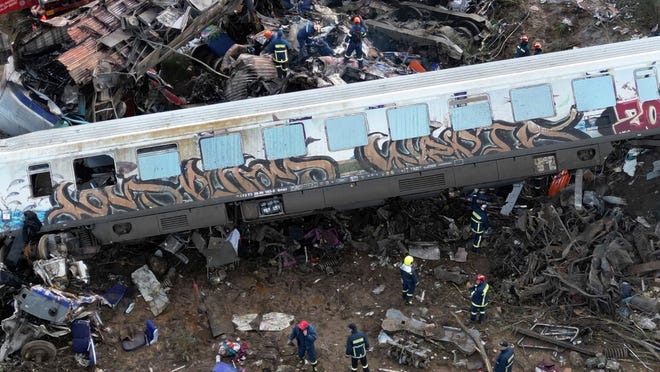The death toll rose to at least 43 and a railway worker was arrested after passenger and freight trains collided near the city of Tempe in northern Greece.
More than 80 people were injured, and the Greek government declared three days of national mourning after the country’s worst train crash.
Train operator Hellenic Rail said the passenger train was traveling from Athens to Thessaloniki, Greece’s second-largest city and a popular tourist destination that describes itself as the “gateway to the Aegean Sea”. The train carried 350 people, including many university students returning home from Carnival, the three-day national festival that precedes the Christian season of Lent.
The two trains collided at high speed shortly before midnight on Tuesday, derailing several cars and at least three bursting into flames, officials said.
Greek Prime Minister Kyriakos Mitsotakis promised an independent investigation and said the crash appeared to be “mainly due to a tragic human error,” but did not elaborate.
Rescuers spent several hours digging into the rubble, listening for calls from survivors. Cranes were brought in to peel away layers of twisted, charred steel.
Eight train workers were killed, including two drivers of a freight train and two drivers of a passenger train, said Yannis Nitsos, president of the Greek Railway Workers’ Union.

Developments:
►Greece’s fire service said late Wednesday that 60 people had been hospitalized, including six in intensive care. Journalist Ellie Kasholi told the BBC that 20 to 25 people were missing but some may have left the crash site unnoticed.
►Greek Transport Minister Kostas Karamanlis resigned on Wednesday, saying it was his duty to step down “out of respect for the memory of those who died unjustly”.
►Flags flew at half-mast outside all European Commission buildings in Brussels.
►Pope Francis, in a message to the president of the Greek Bishops’ Conference, expressed his condolences.
Railway station official arrested
A station master in the nearby city of Larissa has been charged with negligent homicide and negligent grievous bodily harm after two trains collided on Tuesday night, police said. The station master in charge of the signal denied wrongdoing and blamed the accident on a technical glitch. BBC reported.
The station master was identified as 59-year-old, according to the police report. He is due to appear before a prosecutor on Thursday to be formally charged.
Two others have been detained for questioning, police said. Authorities did not immediately release their link to the crash, and no cause was immediately released.
‘There was panic’: Survivors describe terrifying moments
Some survivors said the collision felt like an earthquake.
“We heard a big bang,” 28-year-old Stergios Menenis, who jumped to safety from the wreckage, told Reuters. Then panic ensued. Cables, fire, fire was immediate. We were burned when we returned.”
He described 10 to 15 seconds of chaos amid dangling cables, broken windows and flames — “people screaming, people trapped.”
Stefanos Gogakos was in a back car and said he felt the crash explode. He saw flames at the front of the train.
“The glass in the windows broke and fell on top of us,” he told state broadcaster ERT. “My head hit the roof of the car with a wobble. Some started climbing out of the window as there was smoke in the carriage. The doors were closed, but within minutes the train staff opened them and we stepped out.
Greece is at the bottom of rail safety in Europe
Several studies over the past few years have confirmed that Greece has the highest number of train accidents per capita. From 2018 to 2020, Greece had the highest death rate among 28 European countries. European Union Agency for Railways.
Kostas Karamanlis, the Greek transport minister who resigned following the disaster, said he had tried to improve the railway system, which was “inappropriate for the 21st century”.
Kostas Genidonias, president of the Greek Train Drivers Association, told ERT about the long-running problems with electronic systems that should have alerted drivers.
“Nothing works. Everything is done manually across the Athens-Thessaloniki network,” Zenitonias said. “The indicators, or the traffic lights, or the electronic traffic control are not working.”
Head-on crash: At least 36 killed in train crash in northern Greece; Rescue operations are underway
Confusion and fear within minutes after the accident
“There were several large pieces of steel,” said local resident Vassilis Polisos, who said he was one of the first on the scene. “Passenger and freight trains were completely destroyed.”
When he arrived, the dazed and disoriented people were escaping from the rear cars of the train.
“People, naturally, were scared — very scared,” he said. “They were looking around and searching; I don’t know where they are.”
Florida train derailment:Train carrying propane derails near Florida airport; Officials say no leaks have been detected
The Prime Minister has promised to find out the cause of the accident
Prime Minister Kyriakos Mitsotakis, who described the crash as an “unspeakable tragedy,” traveled to the area, his office said.
“We will find the causes of this tragedy and do everything we can to make sure it doesn’t happen again,” Mitsotakis said.
How did the train accident happen?
The trains crashed just before the valley of Thessaly and Macedonia, about 235 miles north of Athens. Kostas Agorastos, the regional governor of Thessaly, told Greece’s Sky television that the two trains collided head-on at high speed.
“Cars 1 and 2 are now gone, the third one has derailed,” he said.
Survivors said several passengers were thrown from the windows of the train cars by the impact. They said others struggled to free themselves after the passenger train rammed into a field near the gorge.
Contributed by: Associated Press

